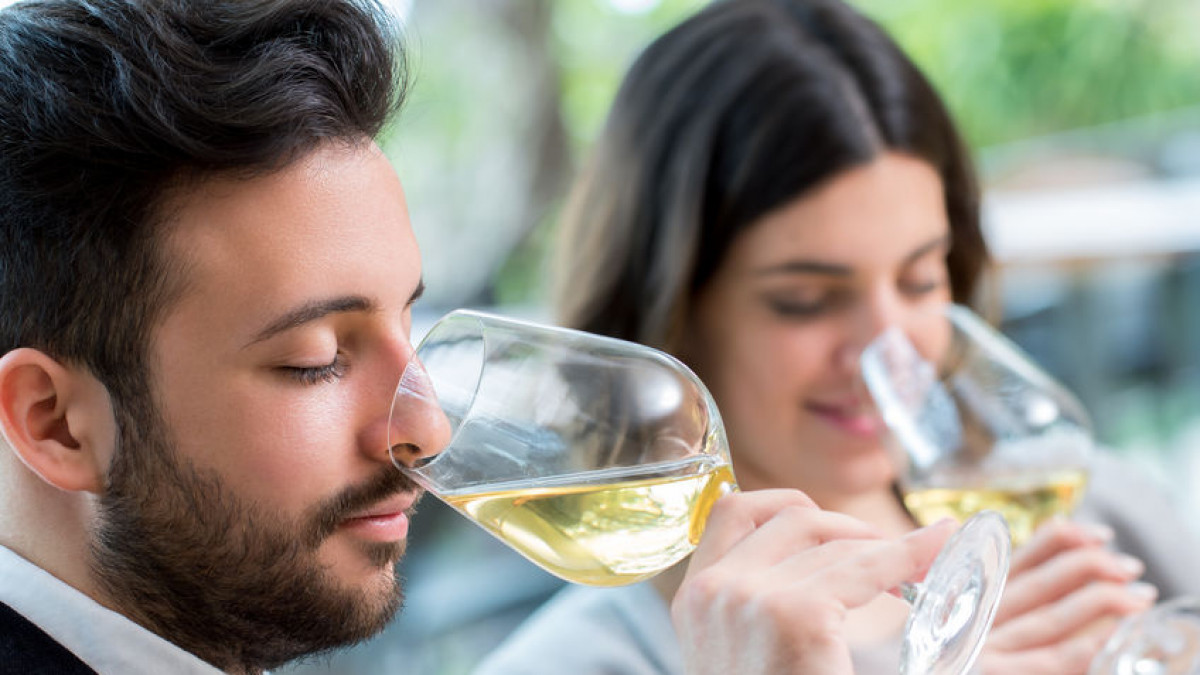Are women better than men at describing wine aromas?

Is it true that women are better than men when it comes to wine tasting, and specifically wine aroma identification?
Published October 14, 2020
Revisited September 21, 2021
Is there any evidence that women are better than men for wine tasting?
That's a question that often comes in conversations and classrooms.
In my role as a taste panel leader, I have noticed that women were more successful at passing the screening tests required to join my panels.
I remember Prof. Köster explaining that women had superior sensory skills due to the traditionally assigned household activities, which required them to use their senses more often than men.
But is it true in wine tasting?
Do women identify wine aromas better than men?
A Brazilian study published in 2017 [1] reported an experiment on that very topic, comparing men's and women's abilities to identify wine aromas.
The scientists selected 20 different aromas covering the fruity, spices, wood, herbaceous, floral, and buttery categories, and some defects.
Twenty-five women and 25 men aged 21-65 years old participated in this study. The task was to smell a flask containing an odor and describe it immediately before moving on to the next flask.
The results showed that women matched the correct aromas, about 57% of the time, while men did the right association 45%.
The data also showed that:
- Women were particularly good at identifying spices, floral aromas, and some wine defects.
- Men performed well at identifying spices and herbaceous aromas. The researchers concluded that their data demonstrated the superior ability of women in identifying wine aromas.
As a scientist, while the Brazilian data confirmed what I had observed in my practice, I questioned the small number of participants and how the evaluation took place.
So I searched for other evidence. I found a meta-analysis of thousands of publications studying if women were better than men in using their sense of smell.
Are there sex differences in human olfaction?
A collective of Polish and German scientists conducted a comprehensive analysis of existing research targeting possible sex differences in olfaction, our sense of smell [2].
We use our sense of smell in different ways, not only to describe or recognize aromas.
We use our noses:
- To detect the presence of an odor (Does this room smells different from usual?)
- To differentiate odors on their intensity or quality (is it gas or a foul odor?) And to describe/identify the odor (it's not a gas, but the vase water that turned bad).
The scientists focused their efforts on studies comparing men and women scores obtained at two different tests:
- Sniffin Sticks Test (SST) to assess detection, differentiation, and identification [3]
- University of Pennsylvania Smell Identification Test (UPSIT) to assess odor identification abilities [4].
The partial loss of smell is a characteristic of several physiological events like aging or neurological diseases.
These two tests are tools validated in many countries and used by the medical community to assess patient abilities to diagnose olfactory disorders.
Therefore, the studies using these two tests tended to be rigorous in their design and execution to allow us to conclude whether or not women are better than men, as far as olfaction is concerned.
The scientists analyzed thousands of test results.
They concluded that "women generally outperform men in olfactory abilities.
The conclusion covered smell detection, differentiation, and identification. However, the size of the differences was small in many instances.
Zooming on aroma identification performance, one test -UPSIT- showed more differences among men and women than SST.
It might be due to the selection of aromas that tend to be more familiar to women than men.
This fact might also be the bias I had in my studies. The samples I chose were food aromas that could be more familiar to women than to men.
Are women better than men at describing wine aromas?
The meta-analyses and the Brazilian study support the fact that women are better at identifying aromas.
However, this superiority may not be genetic. It might be the fact that women tend to be more exposed to certain smells growing up and in their adulthood than men. These aromas happen to be more present in wine.
Repeated exposure to these aromas facilitates their memorization and the ability to detect them at a lower concentration. The familiarity of the smell, once memorized, enables its identification.
Therefore, the secret to performing well at aroma identification is training and practice to become more familiar with the most common and uncommon aromas in wine.
Thanks for reading.
References:
[1] Douglas Andre Wurza, Ricardo Allebrandt, Betina Pereira de Bem, Bruno Bonin, Juliana Reinehr, Adrielen Tamiris Canossa, Leo Rufato, and Aike Anneliese Kretzschmar. 2017. Women have better olfactory perception for wine aromas. 40th World Congress of Vine and Wine. BIO Web of Conferences 9, 04005 (2017) DOI: 10.1051/bioconf/20170904005
[2] Sorokowski Piotr, Karwowski Maciej, Misiak Michał, Marczak Michalina Konstancja, Dziekan Martyna, Hummel Thomas, Sorokowska Agnieszka. Sex Differences in Human Olfaction: A Meta-Analysis. 2019. Frontiers in Psychology, 10, 242
[3] 'Sniffin' Sticks'
[4] University of Pennsylvania Smell Identification Test: a rapid quantitative olfactory function test for the clinic.
Categories: Tasting education
Become a Better
Wine Taster

Discover how to improve your wine tasting notes in no time with these simple steps.

Isabelle Lesschaeve
Principal, Blog author, and Wine Tasting Coach
Internationally renowned wine sensory scientist, Isabelle demystifies wine tasting and helps serious wine lovers sharpen their tasting skills and tasting notes in a supportive community.
InnoVinum LLC is a participant in the Amazon Services LLC Associates Program, an affiliate advertising program designed to provide means for sites to earn advertising fees through advertising and linking to amazon.com.
 Isabelle Lesschaeve
Isabelle Lesschaeve